As Los Angeles continues to experience rising temperatures and more frequent extreme heat events, one proposal gaining traction requires landlords to install air conditioning in rental properties across LA County. While nothing is official, this potential change signals a seismic shift in how landlords approach rental property upgrades. Here’s what you need to know — and why now might be the best time to get ahead with Accurate.
Why LA County Is Exploring a Mandatory AC Requirement for Rentals
Southern California is no stranger to heat, but the last few years have seen record-breaking temperatures that are uncomfortable and dangerous. Because of this, a new list of rental property AC requirements may be coming.
What’s driving the change?
Heat-related illnesses are on the rise, and rental units without adequate cooling options put vulnerable populations, including seniors and children, at significant risk. Public health officials are increasingly treating indoor climate control as a matter of health and safety. This change could create a new form of tenant cooling rights in California.
Growing pressure from tenant advocacy groups
Tenant rights organizations have been vocal in pushing for climate-adaptive housing policies. They argue that landlords have a responsibility to provide safe living conditions, especially as climate change intensifies.
Focus on equity in lower-income housing
Many lower-income residents live in older apartment buildings that lack modern HVAC systems, and these communities often suffer the most during heat waves.
What’s the status of the proposal?
The bill has not yet been passed but is under serious review by the LA County Board of Supervisors and could significantly change California rental housing regulations. A formal recommendation is expected later in 2025.
What would this mean for older and newer buildings?
Newer buildings often already include AC systems, so that rental property compliance with HVAC would be straightforward. Older properties, especially those built before the 1980s, could require significant upgrades.
What This Means for Property Owners and Landlords
So if the law passes, will you be required to add AC units to your property? The simple answer is yes, eventually. Whether your property is a single-family rental or a 30-unit apartment complex, landlord responsibilities with HVAC would likely require each unit to have access to effective cooling.
Benefits of getting ahead of the law
As a landlord or property owner, you are in a unique position to get ahead of the potential AC requirement law. Here are a few benefits to think about:
- Tenant satisfaction: Offering AC can significantly increase tenant comfort and satisfaction, leading to longer leases and fewer turnovers.
- Higher property value: Adding a modern AC system is a long-term investment. Not only does it appeal to prospective tenants, but it also increases your property’s market value.
- Avoid rushed installations: Once a law goes into effect, HVAC contractors will be booked solid. Getting ahead now means you can schedule installations at your convenience.
Best Air Conditioning Options for LA Rental Properties
When considering your new apartment building’s air conditioning retrofit, it’s important to weigh out your options.
Ductless mini-split vs central air
Ductless mini-split systems are cost-effective, energy-efficient, and easier to install, especially in buildings without existing ductwork. They allow for individual room control and tend to be less invasive during installation. Central air, while more expensive upfront, offers uniform cooling throughout the unit and may appeal to high-end renters.
Ductless mini-splits are generally the preferred choice for retrofitting older buildings, especially those with limited duct space, and are easiest to maintain.
Energy-efficient systems for multi-unit buildings
The Seasonal Energy Efficiency Ratio (SEER) is crucial when choosing a system. Higher SEER-rated units are more efficient and result in lower utility bills — an important consideration if you include utilities in rent. California requires a minimum SEER 15 rating, but exceeding that standard can qualify you for incentives.
Installation Considerations for Landlords
As a landlord in California, much like knowing where your electrical panel is, you’re going to want to know the cost to install air conditioning systems in your rental units’ electrical systems. Below are some price ranges for different systems:
- Window units: $200 to $600 per unit — generally not preferred under new proposals.
- Ductless mini-splits: $2,500 to $5,000 per unit.
- Central air systems: $7,000 to $15,000, depending on unit size and ductwork needs.
Bulk installation pricing for multi-family buildings
Installing multiple systems at once can lead to significant discounts. Many HVAC contractors offer bulk pricing for landlords and other membership plans for retrofitting entire apartment complexes.
Timeline and tenant coordination tips
Notifying tenants ahead of time and scheduling around lease renewals or vacancies will ease the transition. Offering rent discounts during construction or working room by room can also help maintain goodwill.
Why Now Is the Right Time to Plan Your HVAC Upgrade with Accurate
There are many reasons to plan your unit’s HVAC upgrade with Accurate right now:
- Avoid long wait times: Acting now gives you access to better availability.
- Off-season pricing: Booking your upgrade now could save you thousands. We also have a few coupon deals currently.
- Local licensed HVAC installers: Our team specializes in HVAC solutions tailored for Los Angeles rental properties.
- Fast quotes and flexible scheduling: Whether it’s one unit or an entire building, we work around your timeline.
- Trusted by Los Angeles property managers: Hundreds of landlords are already preparing for the future. Whether or not the law passes, investing in. AC installation in Los Angeles is a smart move.
Frequently Asked Questions
Can you raise rent if you install new AC units for tenants?
In Los Angeles, many properties built before October 1, 1978, fall under the Rent Stabilization Ordinance, meaning you can’t raise the rent beyond the allowable annual increase. However, you may be eligible for a Capital Improvement Pass-Through, which lets you recover part of the cost of improvements like new AC systems by raising rent within a set limit.
Will older buildings be grandfathered in or need upgrades too?
Most older buildings will need to comply, but likely with longer timelines and possible financial assistance.
How long does it take to retrofit AC into older buildings?
Installation takes one day to two weeks, depending on the system. Mini-splits are faster, but central air may involve more construction.
Are there any rebates for installing new AC units?
Yes! State and local utilities offer rebates for energy-efficient systems, which can offset a large portion of your costs.






